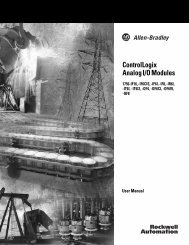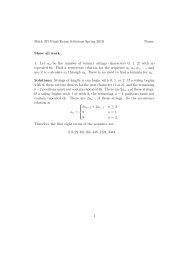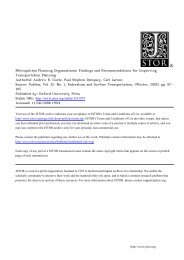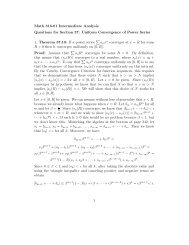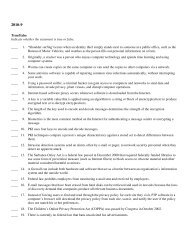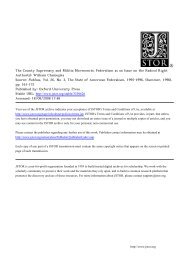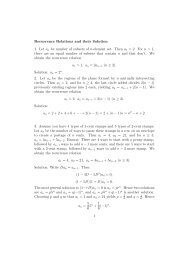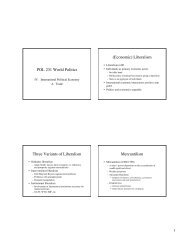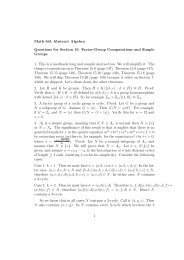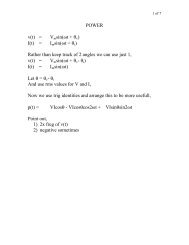Clemons and McBeth - MavDISK
Clemons and McBeth - MavDISK
Clemons and McBeth - MavDISK
Create successful ePaper yourself
Turn your PDF publications into a flip-book with our unique Google optimized e-Paper software.
64<br />
models, expectations, <strong>and</strong> mental constructs precede <strong>and</strong> shape our selection of the data we<br />
then process. Is the problem an economic problem, a legal problem, a political problem, or<br />
not a problem at all? Our answer, the names or categories we apply, will affect which questions<br />
we ask <strong>and</strong> what information we pay attention to. Box 3-2 provides further insight into<br />
the power of ideology by examining the belief in black letter law. This is the common belief<br />
most people have that the law is clear, direct, <strong>and</strong> free from dispute.<br />
Box 3..i!Black--Letter'Lawr'<br />
In Karl N. Llewellyn's famous work on the legal system, The Bramble Bush (1951), he discussed<br />
the idea that whether or not a particular legal precedent applies is a subjective judgment<br />
that depends on taking a strict or loose view. The "loose" view takes the previous ruling<br />
as established law without taking into consideration the context <strong>and</strong> specific facts of the previous<br />
case. The "strict" view would argue that very little of the previous case applies in the<br />
here <strong>and</strong> now of these facts <strong>and</strong> this case. Llewellyn points out that some precedents are welcome,<br />
<strong>and</strong> others unwelcome, to the various judges <strong>and</strong> lawyers involved in the current case.<br />
Students reading Llewellyn are sometimes surprised to consider the idea that precedent (the<br />
legal principle of stare decisis) may be just another subjective tool. Those students are often<br />
even more disturbed by the writings of Jerome Frank.<br />
Jerome Frank was ajudge, a lawyer, <strong>and</strong> earlier, a teacher. Consider the following points<br />
he made in Law <strong>and</strong> the Modern Mind (1963):<br />
As the word indicates, thejudge in reaching a decision is making ajudgmenl. Judges, despite<br />
all their professional training, make decisions just like ordinary human beings.<br />
Just as we do, judges come to a conclusion <strong>and</strong> then work backward to find premises that<br />
will justify their conclusion.<br />
Judges pick <strong>and</strong> choose which precedents to apply to legitimate their decisions.<br />
The judgments of judges are shaped by their education, race, class, economic background,<br />
political background, <strong>and</strong> moral prejudices.<br />
Past experiences with "women, or blond women, or men with beards, or Southerners, or<br />
Italians, or Englishmen, or plumbers, or ministers, or college graduates, or Democrats" can<br />
color our judgment.<br />
Something as minor as a smell, a cough, a yawn, or a gesture can decide what the judge<br />
hears, remembers, <strong>and</strong> believes.<br />
Studies show that given the same set of facts, different judges decide cases <strong>and</strong> consequences<br />
differently.<br />
Judges decide based on hunches<strong>and</strong> are deceivingthemselvesif they think they can ever<br />
escape who they are.<br />
As Kafka's The Trial makes clear, the law is not always what it seems. Jerome Frank's words<br />
make clear that judges are very human. Llewellyn makes clear that precedent is not something<br />
that removes subjectivity from the legal process. More recently, Jonathan Harr's nonfiction novel<br />
(<strong>and</strong> the movie by the same name it inspired) A Civi/Action portrayed a biased judge whose prejudices<br />
had a huge impact on the outcome of this heart-rending case. Black letter law? Nab.<br />
Sources: Kar] Uewellyn. 1951. The Bramble Bush. Oceana Press, as edited in Before The Law, 6th ed. 1998.<br />
John J. Bonsignore et al. eds.; Jerome Frank. 1963. Law <strong>and</strong> rhe Modern Mind. New York: Anchor Books Edition,<br />
as edited in Before The Law. 6th ed. 1998. John J. Bonsignore, et aI., eds.; Franz Kafka. 1998. The Trial. Transtion.lated<br />
New by Breon York: Mitchell. R<strong>and</strong>om New House. York: Schoko Books; <strong>and</strong> Jonathan Harr. 1995. A Ci,'iI Acrion. Vintage Books Edi-<br />
PARTI . THEORY AND PRAClICE CHAPTER3 . CRfTlQUES OF THE RATIONAL ApPROACH 65<br />
Even the decision to measure something reflects certain beliefs. If, after the appearance<br />
of a campus newspaper article on "blow-off' courses, the university or college you attend suddenly<br />
decides to measure how many "A" grades are ending up on the grade rosters its professors<br />
are turning in, it suggests that a problem does exist <strong>and</strong> that the number of As is common<br />
enough to count. Deciding only to count As also suggests that As are different enough from<br />
B+s to count them separately. It also suggests that the grade inflation "problem" is not at the<br />
bottom of the scale (perhaps it is even OK to give social promotions <strong>and</strong> what used to be<br />
known as a Gentlemen's C). It may imply that there are questions about rigor in certain<br />
departments <strong>and</strong> that grades are an accurate reflection of rigor. It implies that the result of this<br />
count may tell us how to resolve the problem: reduce the number of As students receive.s<br />
"Who?" also affects the data in a way perhaps best captured by the NIMBY syndrome.<br />
NIMBY (not in my back yard) reflects the reality that costs are not diffused equally across<br />
society,in a geographicalsense. Toxicwaste incineratorsmay seem a good idea, if they are<br />
located in somebody else's neighborhood. The meaning of the data can even be determined<br />
by where the who? live.<br />
The issue of discounting (adjusting the cost-benefit analysis of a program over time to reflect<br />
the changing value of constant dollars) is another illustration of the power of the who?<br />
to affect data. As with decision trees, discounting plugs a subjective determination by the analyst<br />
into a formula <strong>and</strong> creates the appearance of an objective <strong>and</strong> mathematical fact. The<br />
cost-benefit determination is liable to be entirely different if a discount rate of 5 percent is<br />
used rather than a discount rate of 10 percent. (In Chapter 8, "The Positivist Toolbox," we have<br />
a much more substantial explanation of discounting.)<br />
This relates to the last point we will make relating to who?: namely, that different individuals<br />
shape, select, <strong>and</strong> omit the facts used to make decisions. The Urban Institute studied<br />
welfare reform <strong>and</strong> noted that differences in how the population leaving the welfare rolls is<br />
defined (e.g., length of time off welfare, the reason they left, if they have stayed off) <strong>and</strong> how<br />
outcomes like employment are specifically measured, "have led to employment rate differences<br />
of as much as 20 percentage points for the same geographic areas (Brauner <strong>and</strong> Loprest<br />
1999, p. 3). Braybrooke <strong>and</strong> Lindblom (1970) point out that "multiple conflicting values are<br />
championed by different participants" (p. 17). It is also worth noting that the way we dress up<br />
our statistics, the facts we place at the top of the page, <strong>and</strong> the adverbs <strong>and</strong> adjectives we use<br />
to qualify our findings are reflections of the ideology <strong>and</strong> interests of the analyst.<br />
To evaluate the preceding argument, consider a pledge to increase funding by 100 percent.<br />
Visualize graphing a 5 percent improvement in funding (from the base) over the last four years,<br />
a total of 20 percent. We drew the first graph using 10 percent increments that go from 0 to<br />
100 percent <strong>and</strong> that cover the past three years <strong>and</strong> the next seven years-for a total of 10yearsone<br />
year at a time. We labeled the graph "A Troubled Decade" <strong>and</strong> wrote the following story<br />
about the funding situation below the graph:<br />
At the current pace of funding increases, it will take 16 more years for funding to reacl1 the target<br />
level, <strong>and</strong> by thai time inflation will have significantly discounted the value of the funding.<br />
Next, we used 10 percent increments thai go from 90 to 130 percent to compare funding<br />
four years ago, two years ago, <strong>and</strong> now (it assumes the same funding increases <strong>and</strong> base). We<br />
'Stone's (2002) chapter on numbers, pp. )63-187. provided the general basis for this example,





